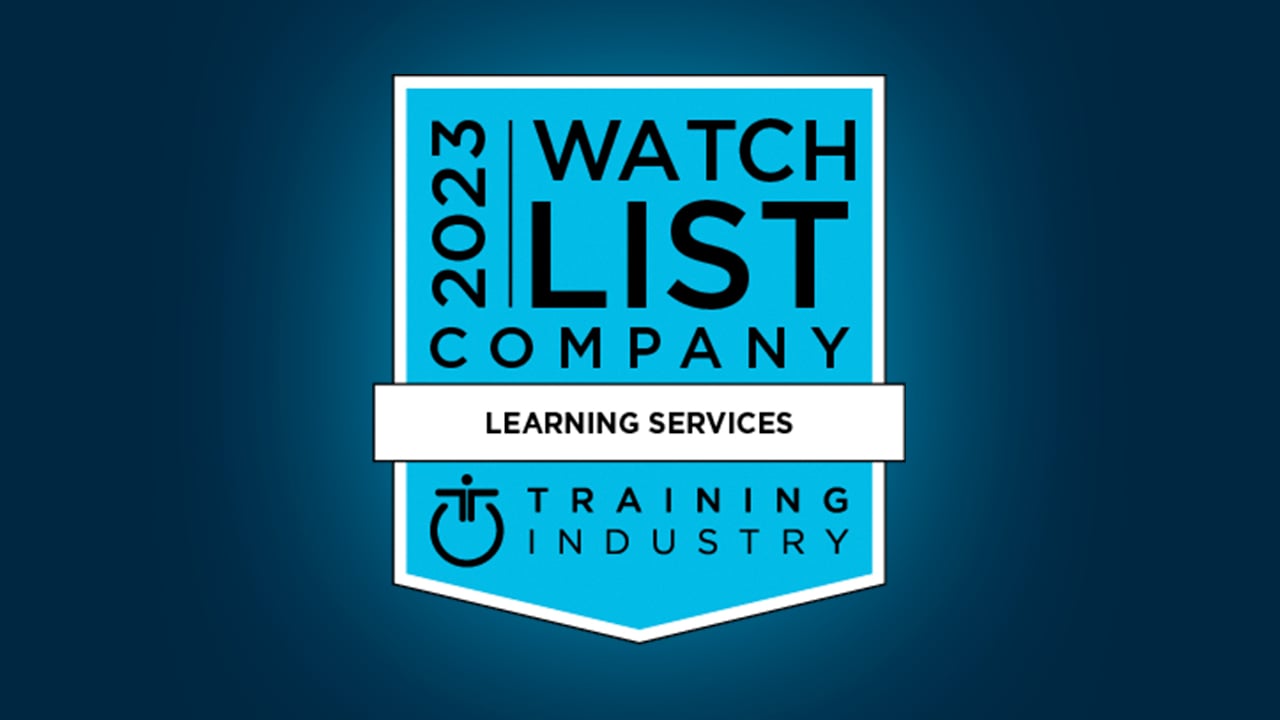7 Considerations When Selecting a Virtual Training Production Partner
The Decision is Made to Outsource – Now What? Virtual classroom producers allow your training team to access the specialized knowledge needed for...
8 min read
.jpg) Dr. Charles (Chip) Dye, Ph.D.
:
Jun 9, 2023 6:00:00 AM
Dr. Charles (Chip) Dye, Ph.D.
:
Jun 9, 2023 6:00:00 AM

Integrating an online virtual classroom into your training program can unlock unique benefits that are unobtainable with traditional in-person or self-paced methods. Live virtual training offers expansive reach and superior efficiency, particularly for remote teams and the hybrid workforce. Unlike self-paced virtual team training, virtual training services bypass the hefty costs associated with content upkeep.

Deciding whether to develop this live virtual training capability internally or to outsource it requires careful consideration and is largely dependent on individual circumstances, much like any outsourcing decision.
If you or your organization have resolved to outsource some or all of your online classroom training services (refer back to my previous post "7 Considerations when Selecting a Virtual Training Partner"), the daunting task of choosing a service provider now lies before you. The landscape has become increasingly saturated over the past three years, presenting a plethora of options for potential buyers. In this blog post, we will delve into the key qualities to look for when selecting a virtual training service provider.
[Partner With InSync Training to Achieve Your Virtual Classroom Outsourcing Goals]
Many of the selection criteria discussed here are not exclusive to virtual training, but the goal of this post is to illustrate what those characteristics (or lack of them) will look like in the virtual training domain.
Whether you are considering outsourcing virtual classroom production/hosting, facilitation, or design, all of these criteria apply.
I’ve also called out some specific considerations for the design and facilitation functions, which require very specific expertise.
Most buyers in the marketplace, with good reason, look at the cost first. The vendor you choose to work with should fit your budget. However, it is vital to be wary of using price as the driving factor in your decision. Many vendors will include more risk—resulting in higher pricing—especially when interacting with new clients who have little experience with virtual training services.
Things like schedule instability in the form of repeated scheduling and cancellation, time changes, etc. can increase the price as processes and expectations are established between the buyer and supplier.
You can reduce the impact of this risk by having a well-formed implementation plan with solid scheduling and coordination processes, meaningful measures for service levels (data collection, language support, preparation expectations with the facilitator, etc.), and well-documented instructional materials. When initially discussing services with a supplier for pricing, communicate what you need to the service provider to ensure you are getting exactly what you need.
I had a good friend in college who slavishly read Fortune magazine to determine what business he wanted to start when he graduated. My take was that if the business is listed as “something to get into” in Fortune, it was already a lost cause because everyone is reading the same article.
Early in the pandemic, a lot of training service vendors jumped into virtual training production and delivery—but without the expertise to back it up. Your goal in selecting a services provider is finding an organization with a wealth of experience. Virtual training should be the principal focus of the supplier rather than a service that is offered secondarily to their primary focus.
Be skeptical of service providers that focus on many things in their offerings, articulating excellence in all, and particularly those that focus on in-person dynamics with virtual training as a secondary service.
In the virtual classroom, a facilitator who is more practiced in in-person delivery may struggle with third-party tools and activities across different virtual classroom technology, especially multiple learning platforms. In our experience, a focus on one domain of training permeates the organizational team. This fact is integral for hybrid team development among other training.
Here at InSync, we are a virtual-only shop and have been for more than two decades. Our team is practiced and very comfortable interacting virtually because that’s how we do our job every day. If virtual training isn’t at the top of the priority list at the supplier, it’s likely that you will experience less-than-optimal service support.
Often referred to as “depth of bench,” this is a measure of the supplier’s ability to staff and work up a team to support your needs across whatever variables your training services require—across time zones, languages, and more. Since many virtual training service providers are fairly lean (don’t have the "depth") in this regard, consider the requirements of your virtual training sessions now. It is also beneficial to make sure that your virtual classroom service provider can provide the scalability you need for virtual classes with more complex needs.
Similar to depth of service support, service breadth is all about what the supplier's virtual classroom producers, including regionalized foreign language, support. Here are some important features when it comes to breadth of service support:
The list is extensive, and you should be able to ask your prospective supplier for guidance and support across these requirements. A key element of virtual training support is the capacity of the producer to support requirements and follow the lead from the virtual facilitator seamlessly to optimize the instructional experience during delivery for the learners. This capability only comes from experience and practice across a wide range of virtual classroom platforms and instructional treatments. Beware of providers who advertise the “we only support Zoom” one-trick pony.
Being there when you’re supposed to be is integral for virtual training from new employee onboarding to leadership development programs and everything in between. A session that isn’t opened on time generally loses that time with participants. People will leave a virtual classroom session at its scheduled end time because they likely have other commitments. One of the strengths of virtual delivery is sequential work with little interruption.
A service provider should provide reliable virtual services offering error rates of less than 0.1%. InSync averages more than 6,000 hours of virtual training production every month. It is exceedingly rare for one of our team to miss a scheduled session. In those rare cases, we have developed processes for customer service excellence to catch the issue before the actual start time and get the session opened by an alternate.
Your organization is convening training to address some requirements with an underlying business need, and a failure of your service provider to convene training on-time reliably is a failure to meet your need.
This is the part many people will skim or glaze over, but it is important nonetheless. Defined, documented, and reliable processes tailored to your needs for scheduling and resourcing are a hallmark of a proven virtual training service provider. Coordination across multiple time zones during the weeks of daylight savings changes, in several languages, on multiple platforms is NOT something accomplished with an Excel spreadsheet and a couple of emails.
The service provider should be able to take your session needs in any format. They should also provide you with a “repeat back” of those requirements in a consistently accessible format with identified experienced personnel in a timely fashion. As a buyer, you should have as much insight into the team resources as you require, including background checks, CVs, etc. It’s important to have the same team of personnel consistently supporting your sessions. If any of these are missing from your prospective supplier offering, continue the search.
[Partner With InSync Training to Achieve Your Virtual Classroom Outsourcing Goals]
Subject matter expertise is often integral to the role of the facilitator to ensure they are well-equipped and well-versed in guiding and facilitating the instructional experience for learners. In some cases, subject matter expertise is not really required, for example, in a seminar format where the learners are peers and meant to evidence the subject matter expertise themselves. Another example is focus groups, a specialized form of virtual session, where the group of participants is guided by the facilitator to produce their own unique conclusions and outcomes.
However, in many instructional contexts, technical expertise allows the virtual facilitator to broaden the instructional experience with anecdotes and field references. Whether these anecdotes be from academia, industry, other resources, or elsewhere, this technical experience enhances learning facilitation of the relevancy and applicability of the instruction.
In such contexts, the facilitator serves a well-established role within social learning constructs that inspires the involvement of learners. It also impacts the perception of the facilitators. Well-versed facilitators are respected as an expert; when the opposite is true, they are often ignored.
In some very effective instructional experiences in which I was a participant, I would remark that the facilitator was teaching “at the 5% level” meaning that it was very apparent to everyone in the session that the facilitator possessed extensive and in-depth knowledge about the subject matter and could provide as much detail as we could ask for at any given time, and that they were only really providing insight into 5% of their expertise.
The role of the virtual instructional designer is to develop an effective instructional experience for the particular learning environment identified including teaching tools for virtual classrooms. If a designer does not have extensive experience in the capabilities of a virtual platform, the virtual classroom experience will not take advantage of all the affordances within the platform. Effective virtual instruction requires much more engagement and energy from the delivery team to interact with participants scattered around the region.
If polling, animations, curated web searches, and all of the other roughly forty methods of interaction available in the virtual classroom with participants are not leveraged and sequenced to build virtual classroom engagement with the material, the outcomes for both the individual and the organization are predictably less-than-optimal. Research on learner engagement here at InSync indicates that properly designed and delivered virtual learning experiences produce
It all starts with designs that incorporate creative ways to engage students online. If the designer’s experience in virtual learning is limited, the design and ultimate outcomes of learners will reflect that limitation.
Once you’ve selected a service provider to support your virtual training needs, the next steps will be dictated by your specific needs. However, there are some additional things to think about to mitigate risk as you roll out your virtual delivery program.
If the service provider you’ve selected supports public or non-proprietary sessions, ask the service provider for you to attend a session to observe the delivery and the instructional experience. If proprietary issues preclude an observed session, review the resumes of the delivery team and evaluate their experience concerning different virtual learning strategies for various learner populations and subject areas in addressing specific needs of learners.
With suitable contractual protections in place, provide the service provider with the instructional materials for a typical session that they’ll be supporting and ask for their insights. In particular, ask about potential challenges in the instructional delivery and any recommendations they have for enhancing the delivery. You’re not looking for free instructional delivery here, but rather asking them how they’d make the delivery as good as it can be. The quality of the feedback you receive will be a good indicator of the service provider’s experience in preparing their team to support your needs.
If operational constraints permit, engage with the service provider on a smaller scale first for a short period of performance. This allows for an initial trial for you to make notes about how things are working out. While you’ll be unable to explicitly determine overall capacity, seeing how the service provider operates is integral in determining if they’re a good long-term fit. It is worth noting that once you’ve selected a service provider for the long haul, they’ll develop in-house expertise on your specific needs and practices that will make the support services more tailored and unique to your organization.
Your procurement department may request a set of measures to develop service level agreements with the supplier. SLAs set a benchmark for expectations on how services will be provided to your company and are critically important for successful virtual delivery whether they’re written into a contract or not. When developing these measures, sometimes called KPIs or “Key Performance Indicators,” focus on measurable, easy-to-collect data that directly impacts the quality of instructional delivery and is attributable to the supplier’s services including
Your training organization can focus on other aspects of the training mandate after making the decision to outsource virtual training needs to a dedicated professional team. This allows you to focus on enhancing the outcomes for your business.
Outsourcing provides access to highly experienced professionals in virtual learning who understand the nuances of virtual classrooms and virtual learning environments. Pre-delivery, third-party training professionals can provide expert advice on adapting design elements to virtual delivery for engaging online learners and achieving an optimal instructional outcome. It also offers the opportunity to identify any potential pitfalls and address these issues before delivery.
During delivery, virtual trainers work to ensure participants have access to the virtual classroom along with quality audio and video streaming capabilities that are optimized for virtual learning. Their goal is to provide participants with a consistent, high-quality virtual experience during their virtual sessions to meet your team and leadership goals. Working with an established and professional virtual classroom production partner reduces risk and gives you access to a broad experience base in virtual instruction to create the best virtual classroom experience for your organization. The key is to find the right supplier.
Maximize your virtual and hybrid learning strategy with InSync Training—your premier managed services provider for virtual classroom solutions. We offer a comprehensive suite of services designed to transform your training program. Our expertise includes Virtual Classroom Hosting/Production, Facilitation, and Custom Design. We work closely with you to understand your unique needs, then design and implement tailored solutions that drive success. With our ongoing support and management, you can focus on what you do best—running your business. Choose InSync Training and elevate your learning experience to new heights! Contact us today.

The Decision is Made to Outsource – Now What? Virtual classroom producers allow your training team to access the specialized knowledge needed for...

2023 Training Industry Top Learning Services Companies Watch List InSync Training, a leading provider of innovative virtual and hybrid learning...
 Read More
Read More